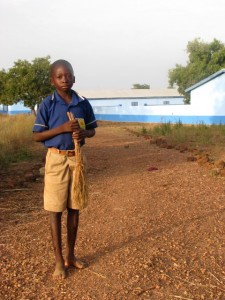 In October 2011 trustees of the Savannah Education Trust visited northern Ghana.
In October 2011 trustees of the Savannah Education Trust visited northern Ghana.
It was an important, busy and memorable visit. We landed in Accra, Ghana’s coastal capital, late in the evening and, after a welcome meal and a few hours rest, set off for the north of Ghana soon after dawn.
We were again reminded of the remoteness of the region, spending 16 hours travelling – initially through attractive hill country and past stalls of bright and exotic produce. Once past the bustling city of Kumasi in the centre of the country, the classic jungle eases into grassland (‘savannah’), the roads empty and the villages become noticeably poorer. The roads are dangerous, and we were thankful to arrive in Lawra late in the evening.
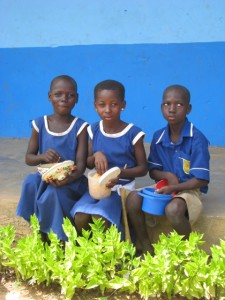 Our week in north-west Ghana was spent in the villages clustered around Lawra. We had many aims: to attend the commissioning of our new schools in the villages of Gberi and Pavuu; to spend time during an ordinary school week at our first school in Bagri; to meet key local partners, including government officials; to visit villages currently without a school; and to discuss the current and future work with the Savannah workers, principally Charles Karbo, our Programme Director.
Our week in north-west Ghana was spent in the villages clustered around Lawra. We had many aims: to attend the commissioning of our new schools in the villages of Gberi and Pavuu; to spend time during an ordinary school week at our first school in Bagri; to meet key local partners, including government officials; to visit villages currently without a school; and to discuss the current and future work with the Savannah workers, principally Charles Karbo, our Programme Director.
Commissioning of the schools
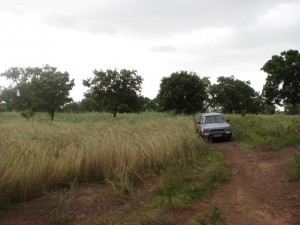 Both schools were commissioned in one very full day: Gberi in the morning and Pavuu in the afternoon. The drive to Gberi is only some 4 miles from the regional town of Lawra, but the charity’s robust vehicle was never more necessary. With no proper road, the approach to the village passes through long grass. Between the straggly green grass we had glimpses of a brilliant blue: the new school. As we arrived we were surrounded by a large crowd of women from the village and the harmonious sound of their song as they danced towards us.
Both schools were commissioned in one very full day: Gberi in the morning and Pavuu in the afternoon. The drive to Gberi is only some 4 miles from the regional town of Lawra, but the charity’s robust vehicle was never more necessary. With no proper road, the approach to the village passes through long grass. Between the straggly green grass we had glimpses of a brilliant blue: the new school. As we arrived we were surrounded by a large crowd of women from the village and the harmonious sound of their song as they danced towards us.
Events at the two villages followed a similar format. We sat under a large canopy on armchairs in front of a table thoughtfully draped in a Union Jack flag. In the burning heat, there were 16 or 17 speeches and short performances by the children (looking very neat in their blue uniform).
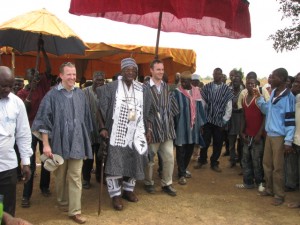 Both occasions were graced by the Paramount Chief of Lawra. He sat under a huge umbrella in his full ceremonial dress including a large medallion from colonial days bearing the head of George V. The government was also well represented with officials from the regional office.
Both occasions were graced by the Paramount Chief of Lawra. He sat under a huge umbrella in his full ceremonial dress including a large medallion from colonial days bearing the head of George V. The government was also well represented with officials from the regional office.
We spoke last, directly before the unveiling of a plaque. It was an opportunity to express many of our heartfelt feelings: thankfulness to God, gratitude to our kind supporters and shared excitement with the children and villagers.
A school in action
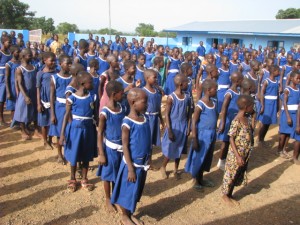 On two days during the visit we travelled soon after sunrise along mud red tracks to the village of Bagri. It was an opportunity to see our first school in action. Bagri School is now five years old and has nearly 400 children. It is, in every sense, a fully functioning school.
On two days during the visit we travelled soon after sunrise along mud red tracks to the village of Bagri. It was an opportunity to see our first school in action. Bagri School is now five years old and has nearly 400 children. It is, in every sense, a fully functioning school.
It was a thrill to see children in striking blue uniform appearing from behind deep grass or walking alongside acacia and baobab trees as they snaked their way to school.
The children gather in the courtyard at the start of each schoolday and we had the privilege of speaking to them before watching them march – to the beat of a drum and in careful formation – into their classes. Some of them had been there even before assembly to help with chores around the school: cleaning and laying out of foodstuffs to dry in the sun in preparation for lunch.
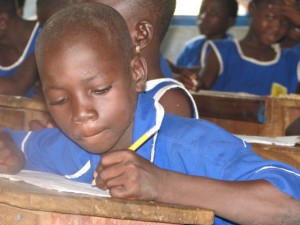 It was fascinating to see classes in action, to meet teachers (and see their accommodation on the ridge overlooking the school) and to view the small farm alongside the school in action. We were impressed with the standard of the teaching, and many of the teachers had passed through Savannah’s teacher scholarship programme.
It was fascinating to see classes in action, to meet teachers (and see their accommodation on the ridge overlooking the school) and to view the small farm alongside the school in action. We were impressed with the standard of the teaching, and many of the teachers had passed through Savannah’s teacher scholarship programme.
A school day at Bagri is not all hard work. We enjoyed hearing the children sing and play the Lobi xylophone. We even had opportunity to watch a game of football and various activities, including a competitive tug of war, on the school field. The morning ended with the free school meal that Savannah provides to each school child. Having started early, the afternoon (as the temperature continues to rise) is a relatively short part of the school day.
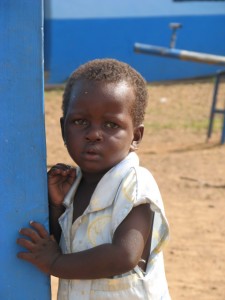 On our second morning in the village we were invited to a community meeting with the villagers to hear their thoughts about the school and to give us opportunity to speak to them. They were kind enough to express their delight with the school (partly in song!) and to present us with gifts: three small wooden stalls.
On our second morning in the village we were invited to a community meeting with the villagers to hear their thoughts about the school and to give us opportunity to speak to them. They were kind enough to express their delight with the school (partly in song!) and to present us with gifts: three small wooden stalls.
Contrasts with other villages
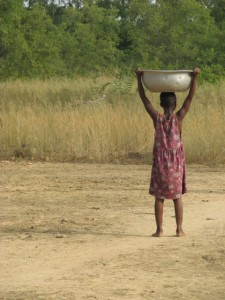 More sobering was time spent in another village, north of Bagri, known in the local Dagaare tongue as ‘the crossing of the stream’. Here children were working long hours with their parents in the fields, helping to pick nuts. The signs of malnourishment were clearly present in many of these children: wasted arms and legs, swollen stomachs and discoloured hair. At a community meeting the villagers expressed their strong wish for a village school.
More sobering was time spent in another village, north of Bagri, known in the local Dagaare tongue as ‘the crossing of the stream’. Here children were working long hours with their parents in the fields, helping to pick nuts. The signs of malnourishment were clearly present in many of these children: wasted arms and legs, swollen stomachs and discoloured hair. At a community meeting the villagers expressed their strong wish for a village school.
While to see such poverty is difficult, the most striking thing we witnessed during our visit was the profound change seen in villages which enjoy a Savannah school. The daily meal provided for schoolchildren has all but eradicated malnourishment, and healthy and well-clothed children are enjoying the benefits of a Christian education. We chatted to many of the schoolchildren who spoke simply but with conviction about the difference a Savannah school has made to their lives.
Meetings with Ghanaian partners
Perhaps less evocative than time spent at the schools – but certainly no less important – were the meetings that we held. At the start and end of our visit we were greeted in the fading pomp of Lawra’s Royal Palace by Naa Puowele Karbo III, the Chief of the area. He expressed his strong support for the work.
On the edge of Lawra, we also visited local government officials, including the District Director of Education. The meetings were very cordial and the government are genuinely pleased to be working in partnership with Savannah. The charity provides the buildings and the government provide the ongoing teacher salary costs.
During our visit we stayed at a guesthouse in Lawra. We used the large sitting room at the guesthouse as a base for some of our meetings: including providing a meal for local government officials and for all of the teachers at Savannah schools. Both occasions were memorable: with lots of short speeches and opportunity for conversations.
Perhaps above all, time spent with those working on behalf of Savannah was crucial: Pastor Charles Karbo (Programme Director), Alfred Sugsuo (Finance Assistant), Pastor James Kori and various other helpers. It was an opportunity to talk about the current work, to talk about the future and simply to spend time together.
**************
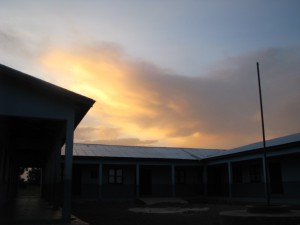 At the end of a particularly hot and busy day we stood outside one of our new Savannah schools. The school, which had been full of activity during the day, was now still. The sun was setting over the Savannah and villagers were using the school’s borehole.
At the end of a particularly hot and busy day we stood outside one of our new Savannah schools. The school, which had been full of activity during the day, was now still. The sun was setting over the Savannah and villagers were using the school’s borehole.
In the calm of the twilight we looked at the blue building in its beautiful, remote savannah setting and felt very thankful – thankful to God, and grateful to our kind and loyal supporters.
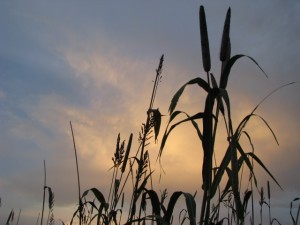 As we reflect on our visit we are also thankful for safe journeys and for the opportunity once again to see the work – and the impact that the work is having on the lives of some of the poorest children in Africa.
As we reflect on our visit we are also thankful for safe journeys and for the opportunity once again to see the work – and the impact that the work is having on the lives of some of the poorest children in Africa.
